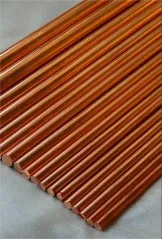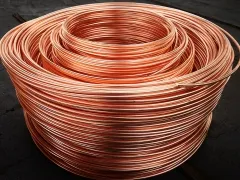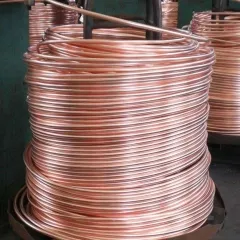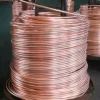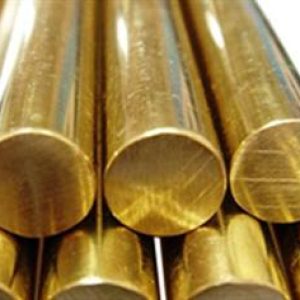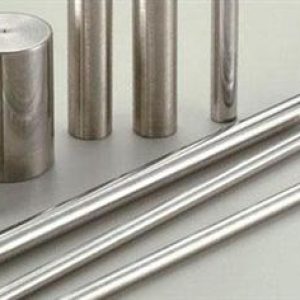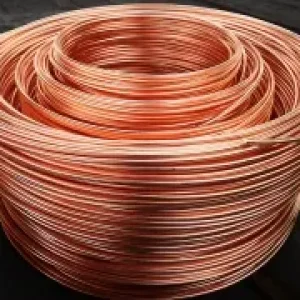Overview of Copper Pole
Copper pole refers to the pole made of molten electrolytic copper through a certain process, which belongs to the wire rod shape. Copper pole is the raw material for producing wire and cable, copper bar and copper rod, and other products.
Advantages of Copper Pole
Copper pole has good electrical conductivity, thermal conductivity, corrosion resistance and processing performance, smooth surface without wire drawing, precise size, high mechanical properties, high copper content, low oxygen content, dense structure, and free supply length. Our product grades have good processing performance and can meet various needs.
Low resistivity: Copper rods have lower resistivity than iron rods, so copper rods are suitable for wire and cable.
Large ampacity: Copper rods have higher ampacity and can transmit more current, so copper rods are often used for power transmission and distribution.
Good elasticity: The copper rod has good flexibility, which allows the copper rod to draw thinner wires and cables, while the copper rod is also easier to weld when connected.
Low coefficient of thermal expansion: The coefficient of thermal expansion of copper rods is relatively small, which means that copper rods do not produce excessive stress when the temperature changes, which can reduce damage to wires and cables.
Good corrosion resistance: The copper rod has good corrosion resistance in the natural environment and some specific environments, which makes the copper rod more suitable for outdoor or humid environments.
Good thermal conductivity: Copper rods have good thermal conductivity, which allows copper rods to be used in radiators, heat exchangers, and other equipment that needs to dissipate heat.
Application of Copper Pole
The copper pole is used in the electrical industry, new energy charging piles, electricians, electrical appliances, power transmission and transformation, molds, hardware processing, and other industries. It is a high-quality conductive material for various high and low-voltage electrical accessories. It is the raw material for producing wire and cable, copper bars and copper rods, and other products.
Company Profile
Copper Channel is a trusted global chemical material supplier & manufacturer with over 12-year-experience in providing super high-quality carbides and relatives products.
The company has a professional technical department and Quality Supervision Department, a well-equipped laboratory, and equipped with advanced testing equipment and after-sales customer service center.
If you are looking for high-quality copper pole, please feel free to contact us or click on the needed products to send an inquiry.
Elemental Content of Raw Materials in Each Grade
| Item | T1 | C11000 | C10200 | C10300 | C12000 | C12200 | |
| Element content | Cu+Ag(≥) | 99.95 | 99.9 | 99.97 | 99.95 | 99.9 | 99.9 |
| P(≤) | 0.001 | 0.002 | 0.002 | 0.004-0.012 | 0.015-0.04 | ||
| Bi(≤) | 0.001 | 0.001 | 0.001 | 0.001 | 0.002 | 0.002 | |
| Sb(≤) | 0.002 | 0.002 | 0.002 | 0.002 | 0.002 | 0.002 | |
| As(≤) | 0.002 | 0.002 | 0.002 | 0.002 | 0.002 | 0.005 | |
| Fe(≤) | 0.005 | 0.005 | 0.004 | 0.004 | 0.01 | 0.05 | |
| Ni(≤) | 0.002 | 0.005 | 0.002 | 0.002 | 0.005 | 0.01 | |
| Pb(≤) | 0.003 | 0.005 | 0.003 | 0.004 | 0.005 | 0.005 | |
| Sn(≤) | 0.002 | 0.002 | 0.002 | 0.002 | 0.002 | 0.01 | |
| S(≤) | 0.005 | 0.005 | 0.004 | 0.004 | 0.005 | 0.005 | |
| Zn(≤) | 0.005 | 0.005 | 0.003 | 0.003 | 0.003 | 0.003 | |
| O(≤) | 0.02 | 0.06 | 0.002 | 0.003 | 0.01 | 0.01 | |
Characteristics of Each Grade Material and Application Fields
| Item | Characteristic | Fields of application |
| C11000 | It has good electrical conductivity, thermal conductivity, corrosion resistance and processing properties, and can be welded and brazing. Impurities containing reduced electrical and thermal conductivity are small, and trace amounts of oxygen have little effect on electrical conductivity, thermal conductivity and processing properties, but it is easy to cause “hydrogen disease”, and it is not easy to process (annealing, welding, etc.) and use in a high temperature (such as 370 °C) reducing atmosphere. | Used in electrical, thermally conductive and corrosion-resistant equipment. Such as: wires, cables, conductive screws, detonators for blasting, chemical evaporators, storage devices and various pipelines |
| C10200、C10300 | It has high purity, excellent electrical and thermal conductivity, no “hydrogen disease” or very little “ammonia disease” (no hydrogen embrittlement), good processing performance and welding, corrosion resistance and cold resistance | It is mainly used as electric vacuum instrumentation devices, various hardware products, lamps, pipe fittings, zippers, plaques, rivets, springs, settlement filters, etc |
| C12000 | Its welding performance and cold bending performance are good, generally no “hydrogen disease” tendency, can be processed and used in a reducing atmosphere, but not suitable for processing and use in an oxidizing atmosphere. The residual phosphorus content of C12000 is less than that of C12200, so its electrical and thermal conductivity is higher than that of C12200. | It is mainly used in pipes, but can also be supplied as plates, strips or rods and wires. Used as gasoline or gas transmission pipes, drain pipes, condensation pipes, mine pipes, condensers, evaporators, heat exchangers, train car parts. |
| C12200 |
FAQ
What is a copper pole?
Answer: A copper pole is a long strip material made of pure copper or copper alloy. It has good conductivity, thermal conductivity, and processing performance and is widely used in the manufacturing fields of wires and cables, electrical connectors, heat sinks, and so on.
What are the types of copper poles?
Answer: Copper poles can be classified into various types based on their copper content and alloy composition, such as pure copper rods, brass rods, bronze rods, etc. Each type of copper rod has its specific physical and chemical properties, suitable for different application scenarios.
What role does copper pole play in wire and cable manufacturing?
Answer: The copper pole is the main conductive material in the manufacturing of wires and cables. Its high conductivity ensures that wires and cables can effectively transmit electrical energy and reduce energy loss. In addition, the mechanical properties of copper rods also enable them to adapt to different bending and stretching needs.
How to choose the appropriate copper pole?
Answer: Choosing the appropriate copper pole requires considering multiple factors, including the required conductivity, mechanical strength, corrosion resistance, etc. In addition, cost is also an important consideration factor. According to specific application scenarios and needs, you can consult professionals or refer to relevant standards for selection.
What is the production process of copper poles?
Answer: The production process of copper poles usually includes steps such as melting, casting, rolling, and stretching. Firstly, the copper raw material is melted and refined to remove impurities. Then, the copper material is processed into rods through casting and rolling processes. Finally, stretch as needed to obtain the required diameter and length.
How to maintain and upkeep a copper pole?
Answer: Regular maintenance and upkeep are required to maintain the copper pole’s good performance and extend its service life. This includes avoiding prolonged exposure to humid or corrosive environments, preventing mechanical damage and scratches, and regularly cleaning and inspecting the surface condition of copper rods.
